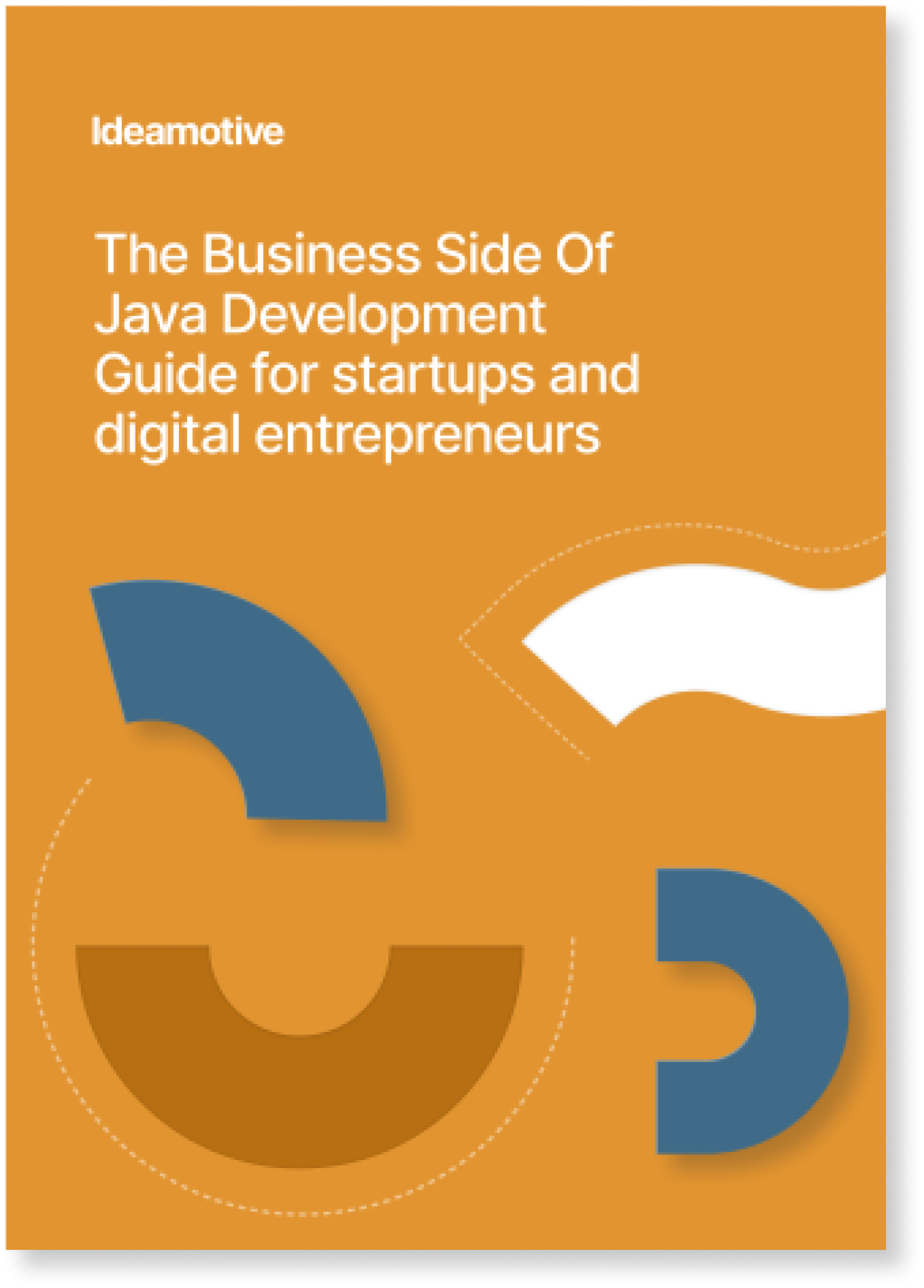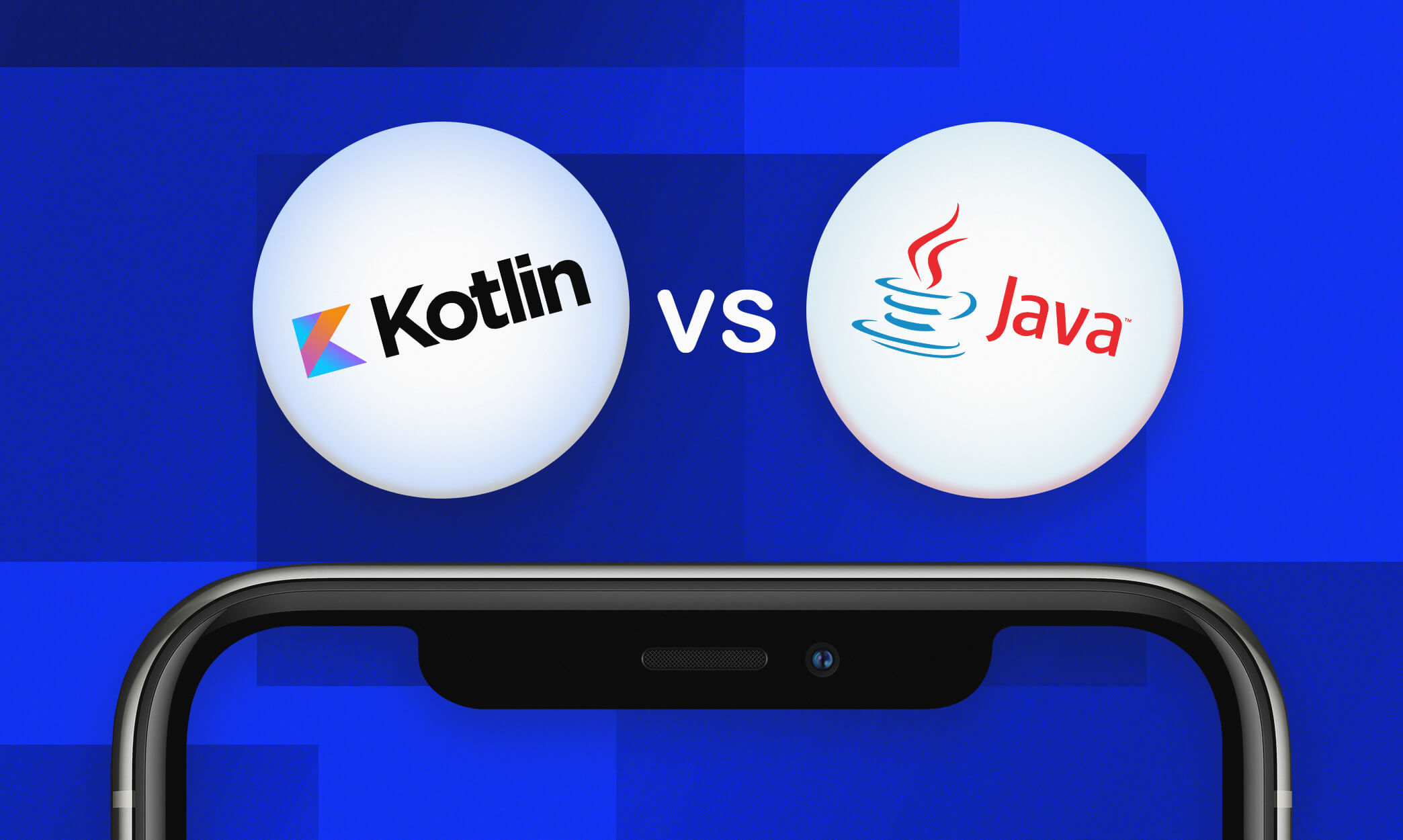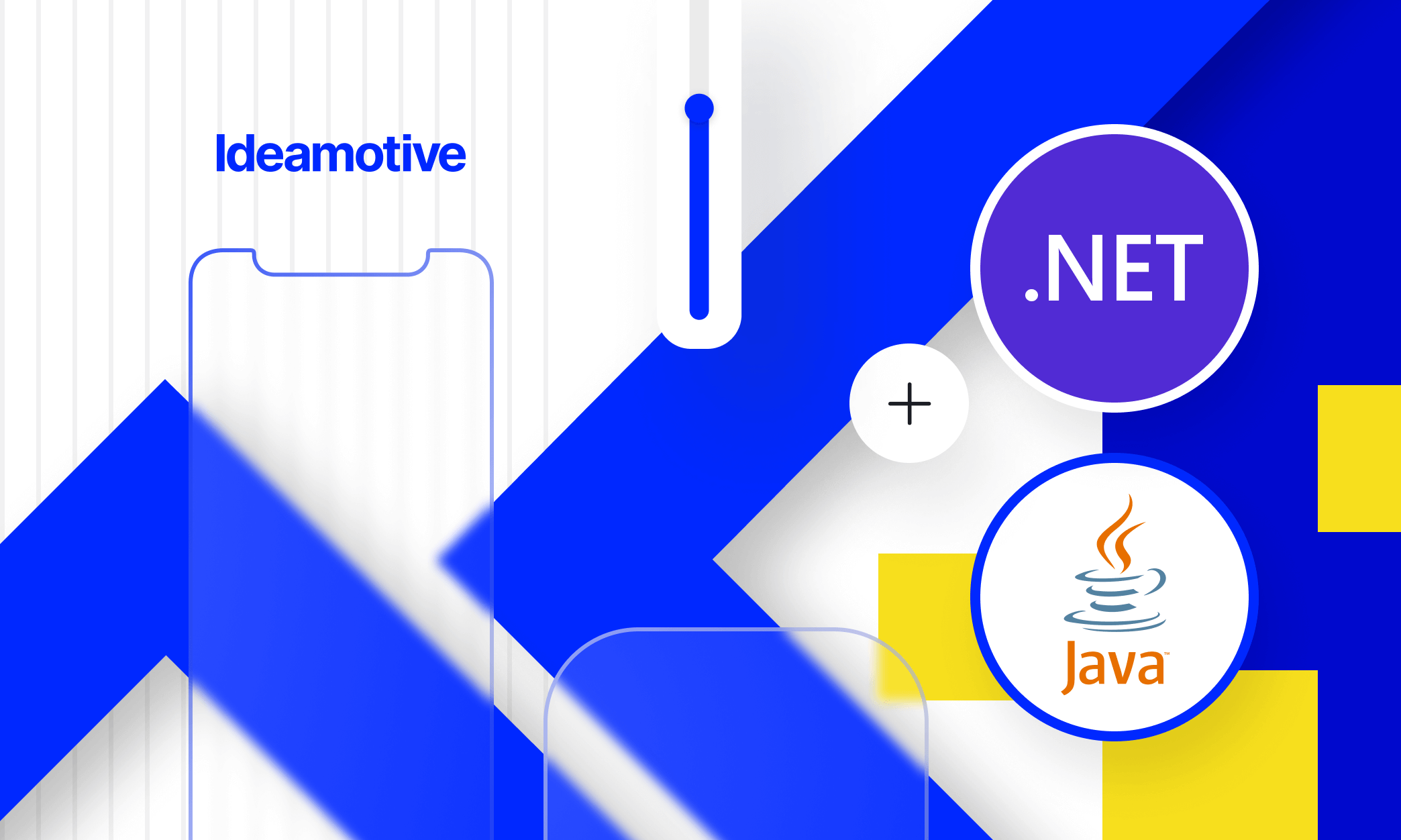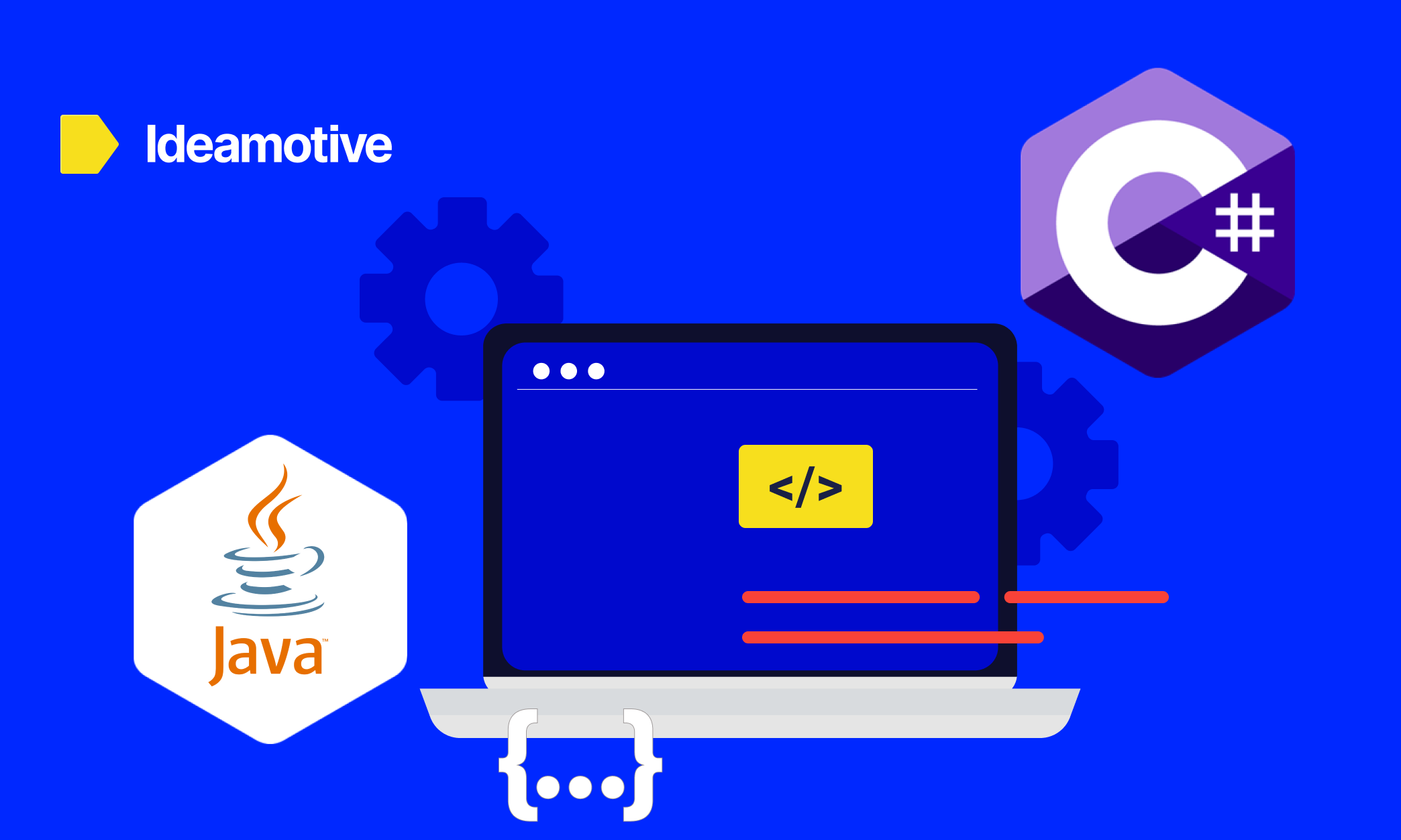Is Java Still Relevant in 2023? State of Java
Aug 7, 202112 min read

Dawid Karczewski
Senior full stack developer and CTO at Ideamotive.

As we journey through 2023, the annual prognostications about Java's supposed decline as a favored programming language continue to echo. Despite this, Java's resilience repeatedly disproves these speculations. Over the past two decades, only C and Java have held the coveted number one position on the TIOBE Index, testifying to Java's enduring relevance. Yet, these recurrent questions persist: Is Java still pertinent in the contemporary tech landscape? What was its status in 2021, and more importantly, what does its future look like?
It is no secret that some expect it to go into obscurity like other once trendy languages like ALGOL, Pascal, and APL. At the same time, others simply look forward to it being so little used, it becomes insignificant to the grander scheme of things due to technological advancements. However, is it always that tech advancements mean the phasing out of older technologies? Let’s find out by looking into the current state of Java in 2023 and then into its potential for the future.
The state of Java at the beginning of 2023
.png?width=602&name=image%20(26).png)
Java is one of the most popular choices of programming languages for large organizations. Due to its timeless qualities, it has remained on top of the ladder and a favorite among huge enterprises. This language’s wide use in the construction of enterprise-scale web apps is unparalleled. However, just like any decades-old language, its relevance has been brought to question. This is because hundreds of languages have been released since Java first appeared on the market, and some believe it is high time it becomes phased out.
Nevertheless, according to a 2020 Stackoverflow survey, Java boasts a 40.2% popularity among developers, with JavaScript having 67.7% and topping the table. This popularity can be attributed to its platform independence allowing a Java program to run on any computer with a Java Runtime Environment installed. Another big win for using Java in 2023 is the possibility of developing an increasingly wide variety of software with it. What is more, software engineers and programmers generally agree that programming in Java is considerably easy and enjoyable. When you have programmers enjoying their work, there will be little to no frustration in the workplace as they work on coding your products. Therefore, the development process becomes more effective and productive. Due to the same reasons mentioned above, Java has vast community support. According to Oracle, The Java community is millions strong and continually growing, strengthening the technology’s relevance today.
According to the 2021 developer productivity report that focused on how the Java community has changed over the past year, 69% of respondents (who could select more than a single preferred programming language) still use Java 8, with 40% using JavaScript and 36% Java 11. Those using Java 12 or earlier constituted 16% of the respondents, while 15% continue using Java 7 or older. These results show how Java remains one of the primary platforms for enterprise application development in 2023. We are talking of applications that large companies use to make money. Such apps require top-notch reliability and a large codebase, making Java a priority as it has these characteristics. So, Java Is a perfect fit in a microservice architecture, and even though it is not the only variant for this, its predictability indeed gives it an edge.
Over the years, this predictability despite crises, disasters, or pandemics has proven to be an excellent characteristic, considering that even just a glimmer of stability in such a destabilized world is needed. It has resulted in the release of two Java updates in 2020 during the COVID-19 pandemic - Java 14 and 15. Nevertheless, as revealed in the previously mentioned 2023 study, Java 8 is still the most popular. This popularity can be attributed to its revolutionary innovations that elevated programmer speed and comfort through functional interfaces and lambda expressions.
As for Java 11s popularity, the secret lies in being the LTS version with official developer support for eight years. The good news is that the next LTS version, Java 17, is expected in September 2023, and with Java’s dependability in releasing updates, you can be assured of its timely release. Java 17 will likely come with more intriguing innovations and well-executed JEP’s from prior versions.
As we have seen, the best Java experts have not been moved from depending on this language to deliver top-of-the-range, scalable products. To shed better light on why this is so, here is a short and precise comparison between Java and some top-rated programming languages in 2023.
Java vs JavaScript in 2023
JavaScript is currently the most sought-after programming language, according to StackOverflow. However, it is only the go-to app when you need an object-oriented scripting language focusing on making more interactive and engaging web pages. Java is the preferred option for creating Android apps, desktop applications, credit card programming, and even web enterprise applications.
That being said, today, without JavaScript and Java, a computer programming module can not be considered complete. All novice web developers need to learn Java and JavaScript, which helps them polish their coding skills. Therefore, if Java is still so strongly comparable to JavaScript, a top-ranking language, and all new developers are learning it, then the question, “is Java still relevant” becomes obsolete.
Java vs Python in 2023
In a ranking focusing on the language most hiring managers look for when hiring developers, the gap between Java and Python is insignificant. Python ranks second with a global percentage of 49.5%, and Java follows closely in third position with 44.1%. An excellent example reflecting this difference is noted in their use in machine learning.
In machine learning, both Java and Python are fantastic when analyzing their easiness to code, speed of coding, and developers pool. The difference is in their versatility, where Python is superior to Java, though to be fair, Java is not a machine learning-oriented programming language. However, when used to its strengths in building enterprise applications aiming to process CRM-class systems and data-heavy operations of ERP, it is a formidable and superior language.
It is undeniable that these two languages are prevalent, and one’s choice mainly depends on preference and the type of project to be executed. This is highlighted in the Tiobe Index, which clearly shows Java’s higher popularity over the years, with Python only going ahead with a small margin recently.
Java vs Kotlin in 2023
Java is a great android app development language. However, it now faces great competition from Kotlin. This relatively young open-source programming language was officially released five years ago and was announced as one of the most preferred android development languages in 2019. However, even though it has seen a sharp rise in adoption, it still struggles to overthrow Java in 2023. This is mainly due to its relatively small development community. In addition , Kotlin is also overshadowed by Java’s superiority in popularity, stability, and ease of learning. Kotlin takes home a small win in the global talent pool, and the two languages draw in other categories like the speed of coding, performance, and documentation. Since there is an increasing number of Kotlin developers worldwide, here is a complete Kotlin guide for Java developers.
The most popular frameworks now
Java frameworks are pre-defined code platforms that allow you to develop software applications by adding your code. How much code you have to add depends on the framework of choice. Some will enable you to use very little code as they supply most of it, and using such a framework depends on the task at hand and its ease of use.
Because frameworks form the substance of programming, the framework of choice can make or break an entire project and determine the effectiveness and speed of your program. However, not all frameworks have the same applications. Therefore, a single programming language can have multiple frameworks. Here are the top ten Java frameworks in their order of popularity:
-png.png)
No programmer wants to build their program on a framework that will make their life short, brutish, and miserable. Therefore, they always keep tabs on the best frameworks within the language of choice and across all languages. Research on the popularity of frameworks in 2023 shows that Spring (the best Java framework) ranks among the top ten most popular frameworks proving its continued relevance. The most popular frameworks across all programming languages in 2023 are:
.png?width=602&name=image%20(27).png)
Note that Spring is on a general upward trend, rising in popularity each year. This uptick in popularity is expected to continue as more updates, and new releases come to Java twice annually. We have been going on and on about how Java’s predictable new releases and updates are helping it stay afloat and competitive. Well, here is some information on Java’s newly released updates.
Java’s newly released updates
Ranging from the second preview of sealed classes to records and concurrent thread-stack processing for garbage collection, in this section you will find some of the latest features rolled out by Oracle’s JDK 16. Also known as Java 16, this newest update has been available since March 16, 2023.
However, JDK 16 is backed by only six months of support from Oracle, with a new Long term Support (LTS) version (JDK 17) expected in September. Therefore, Java 16 is a starting point for the migration to JDK 17.
JDK 16’s new capabilities include the following:
These trigger new deprecation warnings by the designation of value-based primitive wrapper classes and deprecating their constructors for removal. When there is an improper synchronization attempt on instances of value-based classes in the Java platform, a warning is provided.
Java SE: In This JEP, existing value-based classes; specifications of the primitive wrapper classes; and related interfaces and factory methods are polished, thus refining Java SE. In addition, it deprecates the removal of the primitive wrapper class constructors. This does not make any alterations to the Virtual Machine specs or the Java language.
JDK: This JEP brings new logging and warning capabilities to HotSpot and Javac. The annotation @jdk.internal.ValueBased is defined by it and is applied to several JDK classes.
These were previewed in JDK 15 and then in JDK 16. Sealed classes and interfaces restrict which other classes and interfaces may extend or implement them. The plan’s goals include allowing the author of a class or interface to control the code responsible for implementing it; provide a more declarative way than access modifiers to restrict the use of a superclass; and support future directions in pattern matching through the provision of a foundation for analysis of patterns.
Since JDK 9, users have the choice of using the relaxed, strong encapsulation except for crucial internal APIs like misc.Unsafe. This achieves the goal of improving the maintainability and security of the JDK. Subsequently, it encourages the migration of developers from internal elements to standard APIs, resulting in end-user and developers’ ease of update to future releases of Java. However, to curb the risks of the code not running, it is advised to test existing code using a release already in use like JDK 11.
The foreign linker API offers statistically typed, pure-java access to native code. In JDK 16, this API is in incubator mode. The benefit it brings is a considerable simplification of an error-prone native library binding process. Working in tandem with the proposed foreign-memory access API will help achieve this. In the long run, the plan is to replace JNI (Java Native Interface) to offer C support and become flexible to support other platforms.
Other features rolled out include:
- A vector API in an incubator stage.
- Elastic metaspace capacity.
- C++ 14 language features enablement.
- Unix-domain socket channels are included, in which Unix-domain (AF_UNIX) socket support is added to the socket channel and server socket channel APIs in the nio.channels package.
- Porting the JDK to the Windows/AArch64 platform.
- JDK to Alpine Linux porting and to other Linux distributions using musl as their primary C library, on AArch64 and x64 architectures.
- Providing the jpackage tool for packaging self-contained Java applications.
- Providing transparent carriers for immutable data in the form of records classes.
- Migration of ZGC thread stack processing to a concurrent phase from its usual safepoints. This achieves the goal of making stack processing cooperative, lazy, incremental, and simultaneous, among other benefits.
- The ability of Java programs to securely access foreign memory outside the limits of the Java heap with the help of a foreign-memory access API.
- Included is the pattern matching for the instanceof operator, previewed in JDK 14 and JDK 15.
- OpenJDK source code repositories migration from Mercurial to Git.
- Migration to GitHub, related to the Mercurial-to-Git migration, with JDK 16 source code repositories to be on the popular code-sharing site.
What to expect from Java in the future?
The experienced programmer in 20 years is a beginner today, and today’s beginner has a particular opinion about Java that could affect its future. Simply because it is a language that has been around for over 20 years, some tend to think it is antiquated. However, this is not true, as Java remains highly effective and competitive against newer programming languages. Like any language, Java won’t stay on the scene if it does not continue to release new features and updates to keep with the times. Therefore, further development of Java is inevitable. So, Oracle has stepped up and increased the frequency of updates and new releases from once every three years to biannually. What is more, not even the horrid impact of the Covid-19 pandemic on all sectors has slowed them down!
Hence, in addition to 2020’s releases, Java 16, released earlier this year, is to be followed by Java 17, a Long-Term Support version. This will be the first LTS version of Java since Java 11 was released in September 2018. The extended support on JDK 17 is expected to be until September 2029.
The Vice President of Software Development at Oracle’s Java Platform Group, Georges Saab, mentioned some then-upcoming Java features he was confident would make an impact, as reported by Ryan Donovan of Stackoverflow. According to Saab, the four most significant and exciting projects were designed with the code names Valhalla, Loom, ZGC, and Leyden.
Loom
The Loom project loosens the coupling between native threads and Java threads. Java has always had concurrency via threads. However, from the very beginning, they were always tied to an Operating System. What Loom does is, introduce JVM-managed threads and fibers that make way for increased efficient concurrency. This will boost web performance since the Java server-side applications deal with simultaneous users in their thousands.
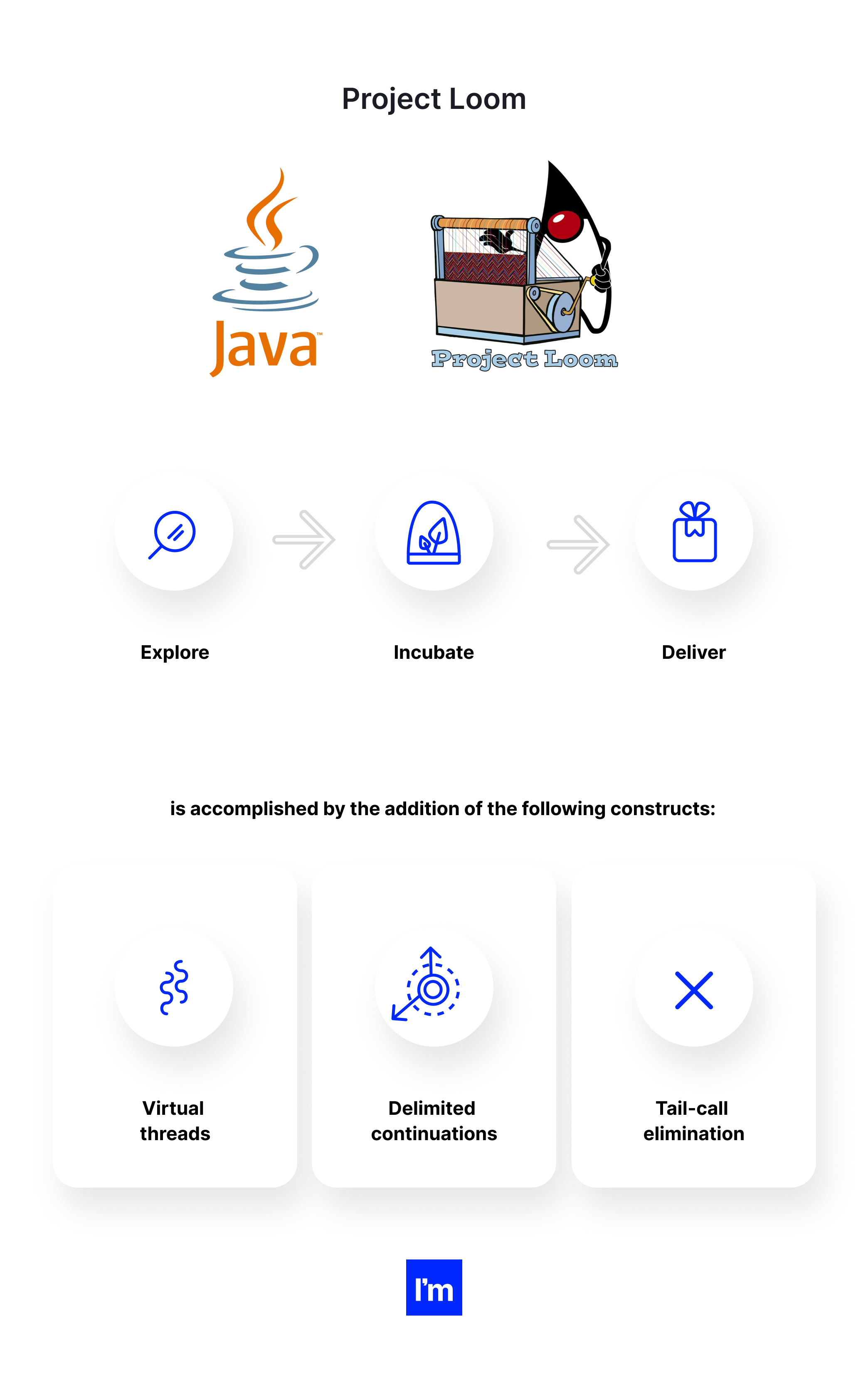
Valhalla
Valhalla aims to revise Java’s memory model and make an allowance for immutable types. Burdening an object with the overhead of a class is dispensable when you have complex data that remains constant throughout the object’s lifespan. The first proposal summed it up well as Saab said: “Codes like a class, works like an int.” “For things like big data for machine learning or for natural language, Valhalla promises to represent data in a way that allows the JVM to fully take advantage of modern hardware architectures that have changed dramatically since Java was created.”
.png?width=602&name=image%20(24).png)
Leyden
Leyden’s main aim is to address Java applications’ start-up time. Though Java is known to be fast, for single apps and monoliths, it at times took long to get going. Commenting on this, Saab is quoted to have said, “That’s great if your app server is going to run for two weeks or two months or two years, but it’s not that great if you want to run for 30 milliseconds.” The key to speed up response times is a quick start, as serverside software is getting more disrupted and smaller.
ZGC
ZGC - a great garbage collector with the ability to handle massive data sizes of up to 16 terabytes with no increased pause time. This is a huge plus for big data applications.
Is Java Still Relevant in 2023? In what situations and for what type of product?
The relevance of every programming language depends on the type of product and situation at hand, and Java is no exception to this rule. Java’s stamina is unparalleled in enterprise-level web apps, banking platforms, and microservices. It remains a widely preferred option that delivers the best quality. So, no industry doesn’t have something to benefit from Java. In finance, for instance, Java is a solid must-know for developers. Hence, Java remains an essential programming language in 2023 and the foreseeable future.
However, this analysis wouldn’t be complete without giving insight into three key areas of Java use. These are web development, application development, and mobile development. So, here is our analysis on the current use of Java in these areas:
Java for web development
Java is excellent for writing server-side code. Therefore, one can use it for backend development, but it is not as competent for front-end development. Nevertheless, Java has object-oriented features and strict variable type handling that makes code written in this language far easier to maintain and modify. Another reason why Java remains relevant for web development and many companies continue to use it is its assortment of outstanding security features that are a must-have for every organization. What is more, Java extends a useable, easy, and flexible code rendered into a comprehensible User Interface. Well-known companies that use Java include Netflix, Uber, Airbnb, Google, Amazon, Pinterest, Slack, to name a few of the known 9721 companies.
Java applets are a must mention when talking about Java as a web development tool. They are delivered as bytecode to be run in web browsers. When one needs to develop a web app or game with high interactivity and without Flash, Java applets provide this functionality. These applets are also used in giving command-line interfaces to remote systems.
Java for application development
Java has millions of libraries available, establishing it among the most suitable languages for enterprise app development. In addition to that, thanks to the Java Virtual Machine feature, Java is highly independent. JVM is so good that many major programming languages like Scala, Kotlin, Groovy exploit it as their runtime. Although Java is expected to be slow, its performance outshines expectations since Java Virtual Machine has been highly optimized for superior performance. Its performance levels mean it can even compete with compiled C applications.
Java for mobile development
When developing mobile apps, your choice of app type and the application’s target platform will determine the programming language of choice. For example, apps for the iOS platform are developed with Objective-C and Swift. On the other hand, Android apps are created using Java (the default since the introduction of android in 2008) or Kotlin.
Java is still going strong as the leading programming language for Android apps. However, Kotlin is providing fierce competition though we can say that Kotlin is just a “cleaner” version of Java. Also, note that Kotlin compiles to Java at an execution level, and one can call all Java libraries from it. To understand the importance of Java and the reach of its influence, of the approximately 6 378 billion smartphone users in 2023, 72.72% use Android devices. As if not enough, there are over 75 000 android app releases monthly since the turn of the year.
Summary
So, is Java still relevant in 2023? The answer is yes! Java is still a top competitor, and it being around for longer than most languages works to its advantage. Today, over 40% of developers worldwide prefer Java, which contributes to why many organizations opt for this language in their development projects. Such an extensive workforce availability makes hiring well-qualified and affordable Java developers manageable for businesses. So, naturally, the number of jobs for Java developers globally continues to grow.
Java is keeping with the times and maintaining its position among the top programming languages by being dependable with updates and upgrades. Even pandemics and crises have not stopped Oracle from releasing a new version every six months. In March 2023, JDK 16 was released, and we are looking forward to JDK 17 coming in September, a long-awaited LTS version with a wide selection of convenient and essential features.
Therefore, do not hesitate to hire Java developers for your project. Here at Ideamotive, we provide top-notch development services across all platforms and programming languages. From Java to Ruby on rails and everything in between and beyond, we have a dedicated software development team that meets your needs.
Looking for Java developers?
When considering using Java for your project, it is essential to engage a team of specialists with the experience needed to develop a professional, high-quality application. They should also furnish you with all vital information on the available options, benefits, drawbacks, and overall costs. Notwithstanding, you should also be well informed about Java hosting and the package required by your application.
That being said, there are dozens of Java and other devs in our network. Contact us, and we will connect you with talents perfectly suited to your company culture and industry.

Dawid is a full stack developer experienced in creating Ruby on Rails and React Native apps from naught to implementation. Technological superhero, delivering amazing solutions for our clients and helping them grow.
View all author postsTrending articles
21 Dazzling Examples of Mobile App UI Design to Inspire You in 2023
Michał Pruciak 7 min read
MedTech vs HealthTech vs BioTech: What Are The Differences?
Michał Pruciak 7 min read
10 Business Applications of Neural Network (With Examples!)
Michał Pruciak 4 min read
10 Irresistible Examples of Web Design Best Practices for 2023
Adam Kozłowski 7 min read
21 Amazing Examples Of React Web Development
Michał Pruciak 14 min read

Looking for a specific type of software development service?
Looking for Java development experts to join your team?
There are dozens of vetted Java professionals in our talent network.
Rated 4.8 / 5.0 by clients from various industries and locations.
